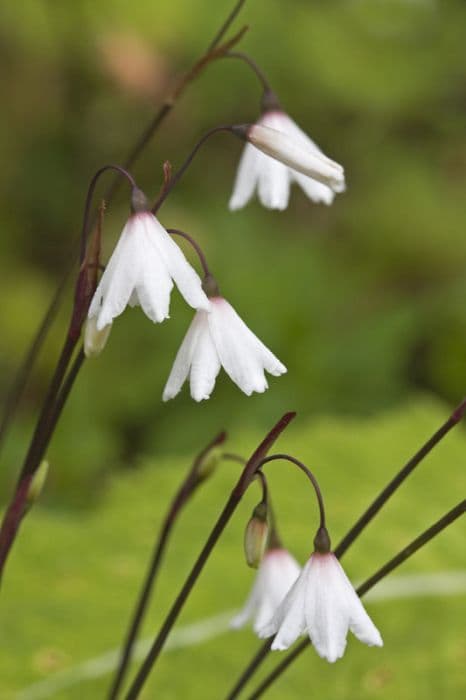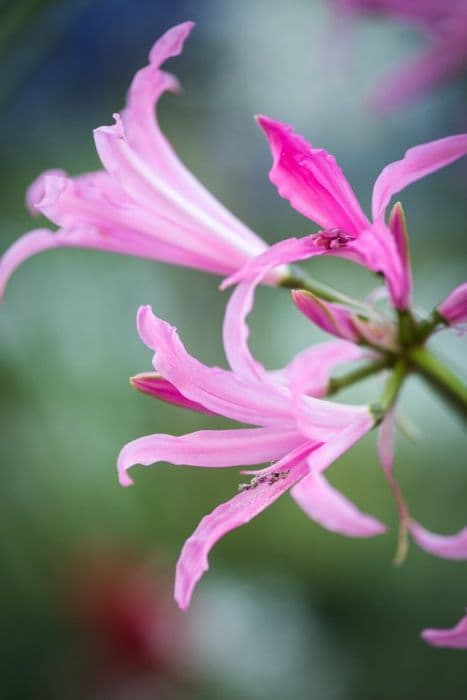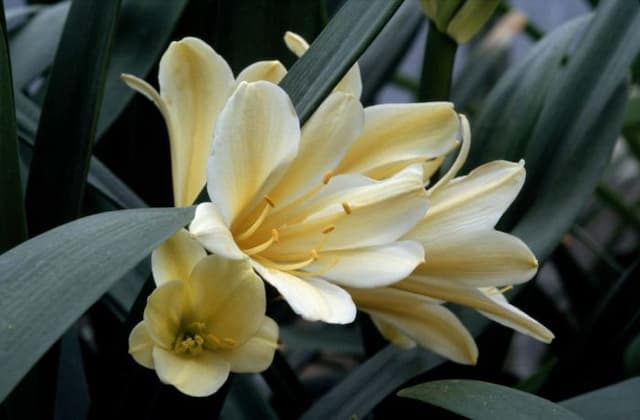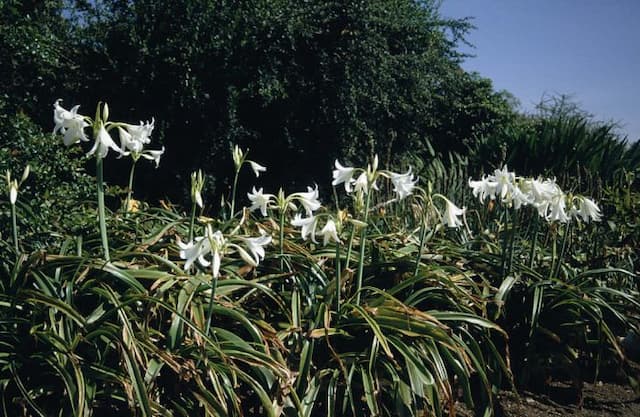Snowdrop Galanthus 'Ketton'

ABOUT
The plant known as Galanthus 'Ketton', commonly referred to as the snowdrop, is a delicate and charming plant typically noted for its early spring flowering. The snowdrop's blossoms are bell-shaped, with three outer petals that are crisp white, curved, and resemble an inverted teardrop. The inner petals usually have distinctive green markings at the tips. These inner petals are shorter and notched, sometimes forming a V-shape, and are nestled within the protective embrace of the outer petals. The flowers dangle from their stems like dainty pendulums, nodding gently in the breeze. The snowdrop has slender, linear leaves that are a bright, fresh green color. These leaves often emerge from the ground folded and then open outwards as they mature, creating an attractive contrast with the white blooms above them. The overall appearance of the snowdrop is one of purity and simplicity, with its color palette limited to mainly greens and whites. The plant has an understated elegance, capturing the essence of late winter to early spring as one of the first flowers to herald the coming of warmer days. The leaves, flowers, and stems of Galanthus 'Ketton' come together to form a plant that is treasured by gardeners for its ability to add beauty to the otherwise bare and dormant landscape of the garden at a time when most other plants have not yet awakened from their winter rest. The appearance of the snowdrop is often regarded as a sign of hope and renewal.
About this plant
 Names
NamesFamily
Amaryllidaceae
Synonyms
Snowdrop, Common Snowdrop, Garden Snowdrop
Common names
Galanthus 'Ketton'.
 Toxicity
ToxicityTo humans
The plant Galanthus 'Ketton' is commonly known as Snowdrop. Snowdrops contain alkaloids including galantamine, which can be toxic if ingested by humans. The toxicity can cause symptoms such as nausea, vomiting, diarrhea, and abdominal pain. In severe cases, it may lead to more serious effects like irregular heartbeats, tremors, and neurological issues. It is advisable for humans to avoid ingesting any part of this plant.
To pets
Snowdrops, including the Galanthus 'Ketton' variety, are also toxic to pets. The alkaloids, particularly galantamine, can lead to symptoms such as vomiting, diarrhea, drooling, lethargy, and incoordination. If a pet consumes any part of the snowdrop plant, it is important to seek veterinary attention as the alkaloid toxicity can be harmful and potentially lead to more serious conditions, such as seizures or cardiac abnormalities.
 Characteristics
CharacteristicsLife cycle
Perennials
Foliage type
Deciduous
Color of leaves
Green
Flower color
White
Height
6 inches (15 centimeters)
Spread
3 inches (7.5 centimeters)
Plant type
Bulb
Hardiness zones
3
Native area
Europe
Benefits
 General Benefits
General Benefits- Aesthetic Appeal: Adds delicate beauty to gardens with its nodding white bell-shaped flowers.
- Early Bloomer: One of the first flowers to bloom in late winter or early spring, signaling the end of the cold season.
- Attracts Pollinators: Provides valuable nectar for early-emerging pollinators such as bees.
- Low Maintenance: Requires minimal care once established, making it suitable for busy gardeners or those seeking low-effort landscaping.
- Naturalizing: Spreads over time to form impressive carpets of white, which can enhance the visual appeal of the area it's planted in.
- Drought Tolerant: Once established, it can survive periods of dryness, reducing the need for frequent watering.
- Cold Hardy: Able to withstand cold temperatures, it's suitable for a variety of climates and hardy in many gardening zones.
- Deer and Rodent Resistant: Often avoided by deer and rodents, helping to reduce garden damage from wildlife.
 Medical Properties
Medical PropertiesThis plant is not used for medical purposes.
 Air-purifying Qualities
Air-purifying QualitiesThis plant is not specifically known for air purifying qualities.
 Other Uses
Other Uses- Galanthus 'Ketton', commonly known as Snowdrop, can be used to signal the start of a beekeeping season as its early blooming can indicate the availability of pollen for honeybees.
- Snowdrop bulbs can be ground into a starch-like substance for stiffening Victorian collars and cuffs, offering a historical laundry aid from the plant's bulb.
- The plant's striking white flowers can be used as a natural dye source, providing a subtle coloring agent for fabrics.
- In folklore, Snowdrops are often connected to purity and are used in various events to symbolize innocence, like christenings or weddings.
- The flowers of the Snowdrop can be crystallized to create decorative cake decorations, giving an edible floral touch to desserts.
- For photographers and painters, Snowdrops serve as an ideal early subject for studies in light and life, marking the transition from winter to spring.
- As a natural pest repellent, Snowdrops can be planted around vegetable gardens to deter certain rodents and insects due to their toxicity.
- In literature and poetry, Snowdrops frequently represent hope and are used as literary symbols to inspire or convey themes of renewal.
- Gardening enthusiasts use Snowdrop bulbs in "in the green" swaps, where gardeners exchange different varieties after flowering to propagate rare types.
- Snowdrops can be used in winter-themed floral arrangements, providing a fresh accent during the colder months when other flowers may not be available.
Interesting Facts
 Feng Shui
Feng ShuiSnowdrop is not used in Feng Shui practice.
 Zodiac Sign Compitability
Zodiac Sign CompitabilitySnowdrop is not used in astrology practice.
 Plant Symbolism
Plant Symbolism- Hope: Galanthus, commonly known as snowdrop, often blooms while snow is still on the ground, symbolizing hope and the arrival of spring.
- Purity: The snowdrop's white color is frequently associated with purity and innocence.
- Consolation or Comfort: In the language of flowers, snowdrops can represent consolation or the comfort of a loved one.
- Renewal: As one of the first flowers to emerge in the year, snowdrops symbolize new beginnings and rejuvenation.
 Water
WaterSnowdrops, or Galanthus 'Ketton', prefer soil that is consistently moist, but not waterlogged. During active growth in late winter and spring, water them generously, providing about 1 inch of water per week if there isn't sufficient rainfall. Once they finish flowering and the leaves start to yellow in late spring, gradually reduce the watering as they enter a period of dormancy. In summer, when the plant is dormant, watering is generally not necessary unless you're experiencing an extremely dry season. Resume regular watering when the first shoots appear in late winter.
 Light
LightSnowdrops like Galanthus 'Ketton' thrive best in partial shade to full sun. The ideal spot for snowdrops is under deciduous trees or shrubs, where they receive dappled sunlight in the spring before the trees leaf out, and then shade during the hotter months. If planted in too much shade, however, they might not flower as profusely.
 Temperature
TemperatureSnowdrops, including the Galanthus 'Ketton', are hardy to cold temperatures and can survive winter chills as low as -20°F, making them suitable for gardens in a wide range of climates. They perform best in temperatures that stay below 65°F during their growing season. Once established, they are quite tolerant of seasonal temperature variations.
 Pruning
PruningSnowdrops, such as Galanthus 'Ketton', generally do not require pruning. The only 'pruning' needed is the removal of spent flower heads to neaten the appearance and prevent seed production if self-sowing is not desired. It's best to allow the foliage to die back naturally, as this helps the plant store energy for the next growing season.
 Cleaning
CleaningNot needed
 Soil
SoilThe best soil mix for Snowdrop 'Ketton' is well-draining and humus-rich, with a pH of 6.5 to 7.5.
 Repotting
RepottingSnowdrops, including 'Ketton', generally do not require frequent repotting and can be left undisturbed for several years.
 Humidity & Misting
Humidity & MistingSnowdrop 'Ketton' prefers outdoor humidity levels, thriving in the naturally fluctuating humidity of its growing season.
 Suitable locations
Suitable locationsIndoor
Place in cool room with indirect light; keep soil lightly moist.
Outdoor
Plant in partial shade, in well-draining, rich soil.
Hardiness zone
3-8 USDA
 Life cycle
Life cycleGalanthus 'Ketton', commonly known as a snowdrop variety, begins its life cycle as a dormant bulb, which awakens in winter or early spring as temperatures start to rise. The bulb sends up a shoot that develops into narrow, strap-shaped leaves and a single flower stalk bearing a nodding, white, bell-shaped flower marked with green, typically in late winter to early spring. After flowering, the plant undergoes photosynthesis to replenish the nutrients in the bulb for the next season. The leaves die back in late spring as the plant enters a period of dormancy during the summer months. During dormancy, the bulb survives underground and may divide, naturally propagating and forming clumps. The life cycle repeats annually, with the bulb re-emerging each winter, leading to years of successive blooming if conditions are favorable.
 Propogation
PropogationPropogation time
Early spring
The most popular method of propagating the Galanthus 'Ketton', commonly known as the snowdrop, is by dividing its bulb offsets. This process should be carried out when the plant is dormant, typically in late spring after the leaves have yellowed and withered. To propagate by division, carefully dig up the clump of bulbs and gently pull apart the offsets from the parent bulb. Each offset should have a portion of the basal plate to ensure it can develop into a new plant. The separated offsets then can be planted immediately, placing them at the same depth they were previously, which is usually about 3 to 4 inches (7.5 to 10 centimeters) deep, and spaced approximately 3 inches (7.5 centimeters) apart to allow for growth. The area should be watered well after planting. The offsets will grow roots and establish themselves over the summer months and bloom the following spring.









